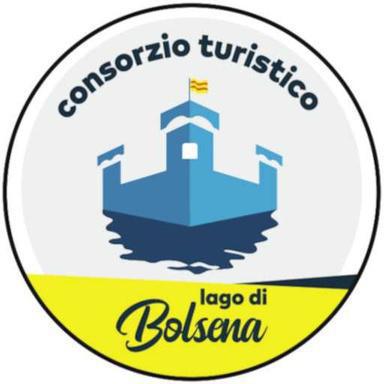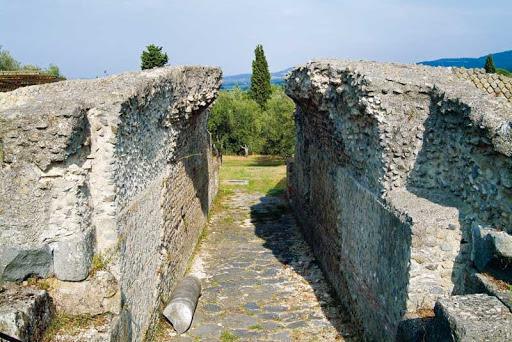History of Bolsena and its Lake
The Europe's largest volcanic lake
Bolsena lake is the largest volcanic lake in Europe. Its origin derives from a volcanic area consisting of numerous eruptive centres; the sinking of the central area of the volcanic zone, has produced this 'caldera' structure, which than was filled by water, forming the lake. It occupies an area of 113.55 km2 and reaches a maximum depth of 151 metres.
The only effluent of Bolsena Lake is the Marta River, while the continuous inflow of water is guaranteed by numerous streams and some springs under the surface of the lake itself. There are two islands in the middle of the lake: Isola Bisentina, famous for its Renaissance buildings and for being the most beautiful and largest island; Isola Martana, the 'smaller', but famous for its lush vegetation and for having hosted the detention of Amalasunta, the daughter of the King of the Goths, Theodoric. She was imprisoned here and then killed by Theodatus, her husband, to take her throne.
A prehistoric lake
The human presence on the shores of the lake can be dated back to the middle Palaeolithic; in fact there are many stone artefacts found in that area, dating back to a period between 100.000 and 35.000 years ago. The Villanovan village, today submerged by the waters, situated in the locality of ''Grancaro'' is the main testimony. Numerous are the finds that have been discovered there and today they are important artifacts exhibited in the Territorial Museum of the Lake of Bolsena-Rocca Monaldeschi.
Etruscan-Roman and Paleochristian Bolsena
The origin of Bolsena is from the Etruscan city of Velzna, which was conquered by the Romans in 264 A.D. and changed its name to Volsinii; the most important families of the time were the Seii, the Anconii and the Rufii, families who entered in the senatorial branch in the 2nd century A.D. Among these, should be remembered the figure of Lucius Aelius Sejanus, a powerful prefect of the Praetorium under the Emperor Tiberius, who had Volsini origins.
Other proofs of the Roman city are linked to the archaeological excavations in Poggio Moscini, which preserve the ruins of important buildings from Volsini's Romanesque civilisation. The influence of Christianity in Bolsena in this period, is undeniable by the numerous and monumental catacombs. The first nucleus of today's basilica is dedicated to our patron Saint Christine: an eleven-year-old girl, who died as a martyr to the Christian faith.
She lived in Roman Volsinii at the end of the IV century and she was the daughter of Urban, magister militum of the city, who subjected her to some tortures to divert her from her conversion to Christianity. The young girl, after resisting to various martyrs, finally died pierced by arrows.
The medieval period and the Eucharistic Miracle
The history of Bolsena in the Middle Ages is closely linked to one family: the Monaldeschi family, lords of Orvieto. Appointed Counts of Bolsena by Pope Martin V, they devoted themselves to the town and its urban planning: they built the majestic Rocca, for defensive purposes and two residential palaces, one in the Castello district and the other inside the borgo, in the area below the castle. After two centuries of control over Bolsena, the rule of the Monaldeschi family ended with the death of Corrado di Paol Pietro Monaldeschi, who, having no heirs, forced Pope Nicholas V to send a commissioner to govern Bolsena.
The most significant event in Bolsena's medieval history is undoubtedly the Eucharistic Miracle of 1263: a Bohemian priest, Pietro da Praga, while was on a pilgrimage to Rome, stopped in the small lake town, on his way. Having serious doubts about the real presence of the body of Christ in the consecrated host, he asked to celebrate mass on the tomb of St Christine.
At the moment of consecration he saw the host in his hands become miraculously real flesh, from which some drops of blood fell. The drops of miraculous blood stained the corporal and some stones of the altar. Than the corporal was carried in procession to Orvieto, where Pope Urban IV was living. After this miracle in Bolsena, the Pope issued a papal bull Transiturus de hoc mundo, which established the feast of Corpus Christi as a solemnity for the universal Church and trusted in Thomas Aquinas to put in writing the liturgy for the celebration of the new feast day.
The "Sacred Stones", of the altar, stained with the blood of the miracle are still preserved in Bolsena, and the Corporal, is preserved in the Cathedral of Orvieto. One of the Sacred Stones, saved in a precious reliquary, is carried in procession through the streets of the town during the feast of Corpus Domini.
Bolsena in modern times
The XVII and XVIII centuries were centuries of 'regular administration' for Bolsena. Worthy of mention is the administration of Cardinal Tiberio Crispo, who wanted to build one of the most famous palaces in Bolsena: Palazzo Cozza Caposavi, which overlooks Piazza San Rocco. This square is very important for the Bolsena community, especially for the presence of the historic fountain: in fact, is linked to the tradition of St Roch, who washing a wound with the water of that fountain, had miraculous effects. To commemorate this event, on 16 August, the water of the fountain is still blessed.
In the second half of the XIX century, an attempt was made to connect the historic centre of Bolsena closer to the lake, thanks to the construction of the monumental avenue named Nicola Colesanti, the mayor of Bolsena and creator of the avenue itself. In 1884, started the first navigation service to reach the islands created by a Piemontese entrepreneur who had bought the Isola Bisentina.
Bolsena : Popes, famous people and... cinema.
Over the time, many travellers have had connection with Bolsena and its lake, some of them have left impressions and others have even written some testimony in their writings. Just to mention a few: among the popes, in addition to the well-known Martin IV, mentioned by Dante in the Purgatory for his gluttony for the eels of Lake Bolsena "drowned" in Vernaccia.
We can mention Pius II Piccolomini, who in his Commentaries narrates he was witnessed of a competition for a prize in his honour, between fishing boats with crews of rowers, each from a different lakeside town. Many other popes have venerated the relics of the miracle of Bolsena, such as Julius II, Clement VII and Paul III. Pius VII stopped in Bolsena on his way back from the exile, during the Napoleonic period. Later, Gregory XVI, Pius IX and Pius XII also visited Bolsena. In more recent times, Pope Paul VI has also been to Bolsena. In 1976, he inaugurated the International Eucharistic Congress from the parvis of the Basilica of Santa Cristina.
During the Jubilee of 1350, on his way to Rome, when he arrived in Bolsena, Francesco Petrarca was kicked by a mule and suffered the consequences for several days. The poet recounts this episode in a letter to Boccaccio and he also mentions the goodness of the lake's eels. Later with the fashion of the Grand Tour, many personalities, from all over Europe, came to visit Italy.
One of the most famous intellectuals of the 18th century, was the Baron Montesquieu, who had the opportunity to pass through Bolsena and didn’t appreciate the town, describing it as "misérable". In the same period, the Marquis De Sade made his Voyage in Italy, in which he describes his impressions travelling along the panoramic road connecting Bolsena to Montefiascone, and he was particularly surprised by the light on the lake and the beautiful landscape overlooking the basin with the two islands.
In addition, Johann Wolfgang Goethe has left a wide documentation consisting of his numerous sketches and drawings, he made during his journey in Italy. Among the English travellers, we must remember the painter-poet J. M. William Turner, who produced paintings in which he captured the out-standing views of some places between Orvieto and Bolsena.
In the same years, between 1842 and 1846, the pioneer of Etruscan archaeology George Dennis also visited the area of Lake Bolsena and left us an important testimony in his famous work The Cities and Cemeteries of Etruria.
In the following century, several writers, musicians and archaeologists passed through Bolsena. Among those who left their impressions we can mention the French musician Hector Berlioz, who saw in the basin of the lake 'a delightful Eden'. Charles Dickens, on the other hand, had the opposite impression, describing Bolsena as a place famous for malaria.
Also Sigmund Freud also stayed on Lake Bolsena more than once. In 1897 the father of psychoanalysis came to Tuscia and visited Orvieto and Bolsena for a few days.
Bolsena and its lake have also been the setting for some films. In the 1954, Violence on the Lake was filmed entirely in Bolsena. The director Mauro Bolognini, on the other hand, chose Bolsena and the Palazzo Del Drago to shoot a part of the film La venexiana, with Laura Antonelli and Monica Guerritore. Carlo Verdone also set some scenes of his film Wedding Journey on the Bisentina island. More recently, in 2006, the director Paul Haggis won an Oscar for the film Crash-Contatto fisico, a film he wrote while staying in Bolsena, at the Palazzo Cozza Caposavi, where he also held workshops for emerging actors. In 2020 the horror film I Liviatani was shot entirely at Palazzo Cozza Caposavi.



